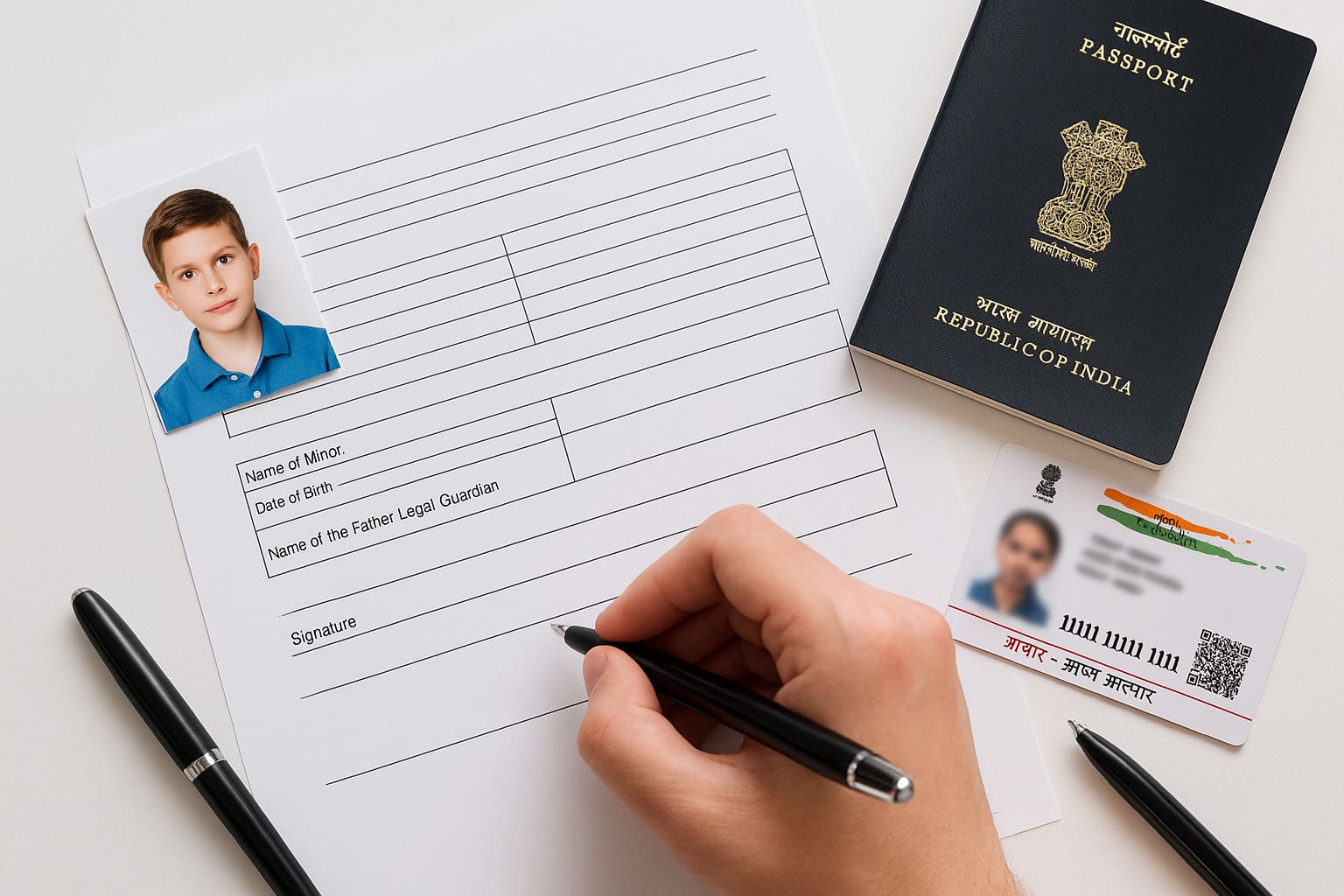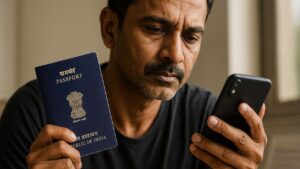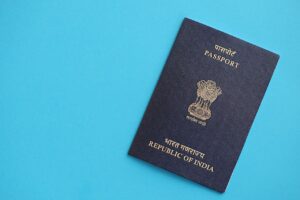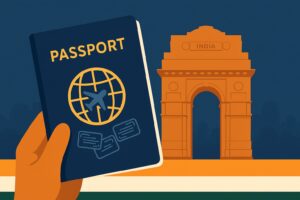
Passport applications for children under 18 need written consent from both parents. This consent is submitted through a form called Annexure D. It is a declaration that confirms both parents agree to issue a passport for their child. This applies to both new passport applications and passport reissues for minors.
When Annexure D is required for passport, different conditions may apply. If a legal guardian is applying instead of a parent, a court order must be submitted along with Annexure D. If one parent is not available, the form must still be submitted along with a death certificate or an affidavit.
If one parent is living outside India, the same Annexure D must be notarised in that country before it is accepted. In cases where one parent cannot sign at all, Annexure C is used as a substitute.
This blog explains where to use Annexure D, how to avoid mistakes, who can sign the form, and how it compares with Annexure C. Every point is explained clearly to help you complete the passport process without delay or rejection.
Need Expert Help on Your Passport Application?
Our passport agents handle forms, documents, and just one call away..
What is Annexure D used for the passport process?
Annexure D is used for passport applications of children below 18 years in India. It is a legal declaration signed by both parents to give written consent for issuing a minor’s passport. The Ministry of External Affairs asks for this form to confirm that both parents agree.
This form is needed in two situations. One is when a child is applying for a fresh passport. The other is when a child needs a passport reissue before turning 18. In both cases, the Annexure D must include names of parents, signatures, relationship to the child, and supporting ID like Aadhaar or PAN.
The Passport Seva Kendra asks for this form even when other documents like birth certificate or Aadhaar card are submitted. The Annexure D works as a consent proof from both parents. Without this, the minor’s passport application is not accepted.
When Annexure D is mandatory in minor passport applications
Annexure D becomes mandatory when the passport is being applied for a child below 18. The Ministry of External Affairs asks for this consent form to verify that both parents approve the passport issue. This applies whether it is the child’s first passport or a renewal before turning 18.
The same Annexure D is used for both fresh applications and reissues. If the minor is still under 18 at the time of submission, the form must be attached. The Passport Seva portal will not allow the process to move forward if Annexure D is missing, even if Aadhaar or birth certificate is already attached.
Use Cases Where Annexure D Is Mandatory
- First-time passport for child below 18
- Passport renewal before child turns 18
- Reissue after damage or lost minor passport
- Minor passport correction request with both parents
- Passport application through Passport Seva Kendra
- When both parents live in India or abroad
The need for Annexure D is based on age, not on whether it is a new passport or a repeat request. As long as the applicant is below 18, the consent form signed by both parents is a fixed requirement under current MEA rules.
Who signs Annexure D form and how it is submitted
Annexure D must be signed by both parents when applying for a passport for a minor. Their full names, clear signatures, and relationship to the child must be filled in as per the passport application. If only one parent is available, the form is still submitted but with added proof—like a death certificate, court order, or a signed Annexure C if one parent cannot provide consent. A legal guardian can also sign Annexure D, but only with a valid guardianship certificate issued by a court.
The completed form must be printed, signed by hand, and attached as a physical document. Annexure D is not accepted in digital format or scanned PDF. The original signed copy is submitted at the Passport Seva Kendra during appointment. For Tatkal or normal applications, the form goes with the rest of the minor’s documents like birth proof, Aadhaar card, and photograph.
Along with the declaration, some basic identity documents are checked to match parental details. These help confirm that both parents’ signatures are listed in the application and that their ID matches the Annexure D declaration.
Checklist with Annexure D
- Printed copy of Annexure D form
- Signatures of both parents or legal guardian
- Aadhaar or PAN card of parents
- Minor’s birth certificate
- Guardianship proof (if guardian is signing)
- Death certificate or Annexure C if needed
- Submit original copy only at PSK
Skipping this form or submitting it with wrong details causes rejection during biometric verification. Submit the correct form, signed on paper, and attach all supporting ID clearly. This avoids delay or rescheduling at Passport Seva Kendra.
Special rules for legal guardians or single parents
If a minor does not have both parents available, the passport application still needs consent. In such cases, the consent must come from a legal guardian or the single parent who is applying. The same form, Annexure D, is used, but with extra proof depending on the situation.
For a legal guardian, a court-issued guardianship certificate must be attached along with the form. This certificate must clearly name the guardian and match the child’s birth certificate. Without this, the application is not accepted by the Passport Seva Kendra. The guardian also needs to submit an Aadhaar card or PAN card for ID verification.
If only one parent is applying, the case depends on why the other parent is not available. If the second parent is deceased, a death certificate is required. If the second parent lives abroad, Annexure D must be notarised in that country. But if the parent cannot be contacted or is legally not involved, then Annexure C is used instead. This form confirms that the applying parent takes full responsibility.
Documents Based on Applicant Type
- Both parents unavailable: Court-issued guardianship proof
- One parent deceased: Death certificate with Annexure D
- One parent abroad: Notarised Annexure D from that country
- One parent not reachable: Signed Annexure C by applying parent
- Guardian applying: Aadhaar, Annexure D, guardianship paper
- Single parent applying: ID proof, birth certificate, Annexure C or D
Every document must match the child’s application and be submitted in original during the PSK visit. If the name or address does not match across Aadhaar, PAN, or birth certificate, the form can be rejected.
Difference between Annexure D and Annexure C in passport
There are two consent forms used when applying for a passport for a child below 18: Annexure D and Annexure C.
Annexure D is used when both parents are available to sign the passport form for a minor. It is a joint consent letter. No additional declaration is needed if both parents are present.
Annexure C is used when only one parent can apply. This may happen if the other parent is not reachable, not involved, separated, or has passed away. The parent signing Annexure C takes full responsibility.
Annexure D vs Annexure C
| Annexure D | Annexure C |
| Signed by both parents | Signed by one parent only |
| Used when both parents give consent | Used when one parent is unavailable |
| Needed for standard minor applications | Needed for exception-based applications |
| Supported by Aadhaar and birth proof | May need legal or death certificate |
| Used when both parents are alive | Used in single parent or guardian cases |
| Must be submitted at Passport Seva Kendra | Must be submitted with valid reason |
Choose the form based on who is applying. If both parents are involved, do not use Annexure C. If only one is applying, Annexure D will be rejected.
Notarization rules if one parent is outside India
If one parent is living outside India, the Annexure D must still be signed. That signature must be notarised in the country where the parent is currently staying. The notarised form confirms that the parent has seen the document, agreed to it, and signed it willingly. Without this notarised copy, the passport application for the minor is not accepted at Passport Seva Kendra.
The Ministry of External Affairs accepts Annexure D only if it is physically signed and notarised. This can be done either at the Indian Embassy or by a recognised Notary Public in that foreign country. The notarisation must clearly show the stamp, name, date, and seal of the authority. Scanned printouts or unsigned soft copies are rejected.
Notarisation Checklist for Parent Abroad
- Sign Annexure D in black ink only
- Visit Indian Embassy or any Notary Public
- Make sure stamp, seal, date are clear
- Submit hard copy during PSK appointment
- Do not send scanned version or photocopy
- Keep Aadhaar or PAN as ID proof reference
If the notarised Annexure D is not correct or is missing any stamp, the file may get blocked at the Regional Passport Office. Always check the latest rules on the Passport Seva portal and prepare the form before the slot date.
Common mistakes that lead to passport rejection with Annexure D
Annexure D must be filled and submitted correctly, or the minor’s passport application may get rejected at the Passport Seva Kendra. The Regional Passport Office checks every detail of the form, including parent signatures, document matching, and official seals. Even a small mistake can hold the file or send it back for correction.
Common Reasons for Rejection
- Only one parent signature when both are available\
- Parent name mismatch with Aadhaar or PAN
- Missing stamp or seal on Annexure D form
- Wrong date or blank space left in declaration
- Signatures not matching with supporting ID proof
- Photocopy submitted instead of original document
- Birth certificate details not matching with Aadhaar
- Notarised copy missing if parent is abroad
Every field on the form must be filled as per passport records. The signature, date, and parent ID should match the application. If anything is skipped or mismatched, the RPO system blocks the file and the slot must be rebooked.
Where to get and how to fill Annexure D form
The official Annexure D form for passport applications is available on the Passport Seva portal at passportindia.gov.in. This format is provided by the Ministry of External Affairs and is accepted at all Passport Seva Kendras and Regional Passport Offices. Always download the latest version directly from the site to avoid format issues.
When filling the form, use clear block letters with a black pen. Write the full names of both parents, sign in the correct boxes, and make sure the names match the details on Aadhaar and birth certificate. Do not leave any blank fields. If you are filling Annexure D for the first time, it is helpful to see how the form should look once filled. You can check this Annexure D filled sample guide on The Passport Agents to avoid small mistakes.
Basic Rules While Filling Annexure D
- Use black ink and capital letters
- Do not use short forms or initials
- Sign in the exact boxes given
- Match child details with Aadhaar and birth proof
- Fill the form after printing only
- Never submit handwritten scanned copies online
Double check the form before taking it to the Passport Seva Kendra. Small errors like wrong signature or blank spaces can delay the application. Always carry the original printed and signed Annexure D on the day of your passport appointment.
FAQs
Annexure D is needed for Tatkal passport of minors
Every Tatkal passport for a child still requires Annexure D. The form confirms that both parents have given written consent. Even under Tatkal, the PSK team will not proceed without this declaration. RPO may still request police verification after issue.
Same Annexure D cannot be reused for another file
Each passport file must carry its own signed Annexure D. The form is linked to the ARN and date. Reusing an old one, even for the same child, will lead to rejection at Passport Seva Kendra.
Annexure D must be printed in black and white
The print does not need to be in color. Use a clean black and white A4 printout. Ensure all text, boxes, and signatures are clear. The PSK team only checks visibility and accuracy.
Scanned or digital copy of Annexure D is not accepted
PSK only accepts physical original copies. If you carry a scanned version, even on letterhead or shared via email, your file may be cancelled at the counter without processing.
Aadhaar is not compulsory on Annexure D but helps
Aadhaar is not a mandatory field on this form. But including the Aadhaar number helps PSK staff match the parent’s ID with their declaration. It also supports verification at RPO level.
Annexure D can be filled by hand or typed
You can either fill it manually with a pen or type it before printing. In both cases, signatures must be done by hand in black ink. Capital letters are preferred for clarity.
Blue ink signatures can cause form rejection
Ink mismatch has caused delays in many cases. One parent signs in black, the other in blue—RPO flags it. Stick to black ink only. This avoids unnecessary objections.
Annexure D can be signed before appointment date
The form can be prepared in advance. Just make sure the signature date is not more than 30 days old at the time of appointment. Older forms may be refused without notice.
Aadhaar name mismatch can delay minor’s passport
If a parent’s name on Aadhaar does not match the passport form or Annexure D, it may trigger document mismatch. Fix Aadhaar before submission or attach another valid ID like PAN card.
Once submitted, Annexure D cannot be withdrawn by parent
If the form is signed and handed over at PSK, it is treated as full consent. Withdrawal later is not possible unless you go through legal steps and submit official court documentation.
Still Confused About the Process? Talk to a Passport Agent Today
Final tips for submitting Annexure D correctly
Annexure D is a legal declaration. If filled wrong or signed with mistakes, the passport file can be blocked at Passport Seva Kendra. Before submitting, check every detail, including name spelling, signature ink, and Aadhaar match. This form is verified line by line at the counter. Any blank field or mismatch can stop the process.
Submission Checklist for Annexure D
- Print the form on clean white A4 sheet
- Use only black ink for all signatures
- Do not leave any column empty or unchecked
- Both parents must sign before PSK visit
- Keep a self-attested photocopy in your file
- Get notarisation done if parent is abroad
Take five minutes to recheck Annexure D before your passport slot. That small step can save weeks of delay at the Regional Passport Office.
 Passport Guide
Passport Guide

